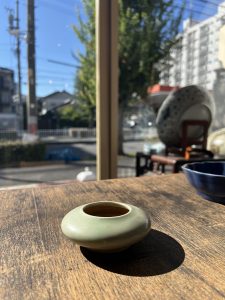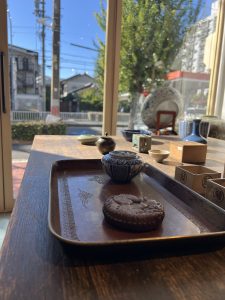1800年前のわんちゃん(愛知県名古屋市千種区姫池通 骨董買取 古美術風光舎)
2025.10.09
本日、ここ名古屋はすっきりとした秋晴れ。
店舗の窓も全開にしているのですが、さわやかな風がすーっと通りぬけて爽やかですね。先日の美術館巡りではないですが、こんな秋晴れですと、どこにで出かけようか、何をしようか、じっとしていられなってくるのですが、皆さまこの秋のご予定はいかがでしょうか。

ようやっと涼しくなったので、このところ日中の明るい時間帯に犬の散歩をしている方も増えたように思えます。猛暑の頃は早朝や夜の涼しくなった時間帯にしていたのでしょうね(我が家の前の自分調べ)。わんちゃんも大切な家族、皆さん気遣っているようです。
本日は、そんな家族のようなわんちゃんのニュースが目にとまりました。
女王卑弥呼(ひみこ)が治めた邪馬台国の有力候補地である奈良県桜井市の纒向(まきむく)遺跡(国史跡)にて、3世紀後半の犬の骨が出土し、その骨から当時の犬の姿が2025年復元されたようです。
そのわんちゃん、「纒向犬」と呼ばれるようですが、市教育委員会と市纒向学研究センターが22日発表した内容によりますと、「纒向犬」は1歳半以上のメスでして、茶とグレーの色違いの2匹の模型を製作したようです。骨格から精密に復元したのは、弥生時代の集落跡で知られる亀井遺跡(大阪府八尾市など)の弥生犬に次いで全国2例目であります。
そもそも犬の骨が見つかったのは2015年1月。3世紀前半では国内最大級の大型建物跡がある居館エリアの区画溝にてほぼ一体分見つかりました。その後市纒向学研究センターは18年に復元方針を決め、考古学や解剖学、進化生物学などの学際的な研究チームを組織し、骨の3次元レプリカをつくって骨格を組み上げ、足りない部分は亀井遺跡の犬の骨を参考に復元が2025年に完成しました。
纒向犬は体高約48センチ、体長約58センチ。現在の紀州犬や四国犬のメスと同程度の大きさで、柴犬(しばいぬ)より一回り大きいようですね。弥生犬と比べると頭が小さく、足と足先が長い華奢(きゃしゃ)な体格だったとみられるのですが、こうした特徴は弥生時代の犬の系譜に位置付けることが難しいようで、中国大陸・朝鮮半島から連れてこられた可能性もあるようです。毛色は不明のようですが、前後の時代の犬の遺伝情報(ゲノム)から推定したとのことで、今回は茶とグレーの2匹が復元されたようです。
ニュースにあがっている復元された纏向犬のレプリカの画像をみたのですが、お顔は細長くキリっとしていて、足が細くて長い印象でして、スタイルがいいです笑。そして今回、このわんちゃんの名前を公募したところ、公募の結果、平仮名で「こまき」と決まったようです。
偶然にも春に箸墓古墳の辺りを訪れたのですが、どういった経緯でこまきが纏向に眠っていたかはわかりませんが、あの穏やかな風景の中、卑弥呼か?卑弥呼のような要人か村人か存じませんが「こまき」と戯れていた1800年前のシーンを思い浮かべてしまうわけでして…。そして、脳内で急に「こまき」があの風景の中を走りぬけて動きだしたりと、そろそろ私の妄想も止まらなくなっていましたので、ここまでとしておきましょう。
それではごきげんよう。(スタッフY)

Today, here in Nagoya, we’re blessed with a crisp, clear autumn day.
With the shop windows wide open, a refreshing breeze sweeps right through—it feels so invigorating. It’s not like my recent museum hopping, but on a day like this, I find myself restless, wondering where to go or what to do. How are your plans shaping up for this autumn?
Now that it’s finally cooled down, I’ve noticed more people walking their dogs during the bright daytime hours lately. During the intense heat, they probably stuck to cooler times like early morning or evening (based on my own observations in front of my house). Dogs are cherished family members, and everyone seems to be taking good care of them.
Today, I came across news about one such beloved canine family member.
At the Makimuku Ruins (a National Historic Site) in Sakurai City, Nara Prefecture—a leading candidate for the location of the Yamatai Kingdom ruled by Queen Himiko—dog bones from the late 3rd century were unearthed. It seems the appearance of dogs from that era will be reconstructed by 2025 based on these bones.
This dog, now called the “Makimuku Dog,” was a female over one and a half years old, according to an announcement on the 22nd by the City Board of Education and the City Makimuku Research Center. They created two models: one brown and one gray. This precise skeletal reconstruction is only the second such example in Japan, following the Yayoi-period dog from the Kamei Ruins (in Yao City, Osaka Prefecture, etc.), known for its Yayoi-period settlement remains.
The dog bones were originally discovered in January 2015. They were found almost intact in a boundary ditch within the residence area, which contains the remains of one of Japan’s largest structures from the early 3rd century. Subsequently, the Ichimatsukō Research Center decided on a reconstruction plan in 2018. An interdisciplinary research team combining archaeology, anatomy, and evolutionary biology was organized. They created a 3D replica of the bones to assemble the skeleton, using bones from the Kamei Site dog as reference for missing parts. The reconstruction was completed in 2025.
The Matsukō Dog stands approximately 48 cm tall at the shoulder and measures about 58 cm in length. This size is comparable to modern female Kishu or Shikoku dogs, and slightly larger than a Shiba Inu. Compared to Yayoi dogs, it is thought to have had a smaller head and a slender build with long legs and feet. These characteristics make it difficult to place within the lineage of Yayoi-period dogs, suggesting it may have been brought from mainland China or the Korean Peninsula. While its coat color remains unknown, it was estimated based on genetic information (genomes) from dogs of preceding and following eras. This time, two dogs—one brown and one gray—were reconstructed.
I saw images of the reconstructed Mamukō Dog replica featured in the news. Its face is long and sharp, and it gives the impression of having slender, long legs—it has a great figure, lol. Then, when they held a public contest to name this dog, the chosen name was “Komaki” in hiragana.
Coincidentally, I visited the area around Hashihaka Kofun this spring. While I don’t know the exact circumstances of how Komaki came to rest in Makimuku, imagining that serene landscape makes me picture someone—Himiko? or some other important figure like Himiko, or perhaps just a villager… I couldn’t help but imagine a scene from 1800 years ago, playing with “Komaki”… And then, suddenly in my mind, “Komaki” started running through that landscape, moving about… My imagination was getting out of control, so I’ll stop here.
Well then, take care. (Staff Y)
*******************
ご実家の整理やお片付けなどをされている方のご相談などが多くございます。
お片付けなどくれぐれもご無理のないようになさってくださいませ。
風光舎では古美術品や骨董品の他にも絵画や宝石、趣味のお品など様々なジャンルのものを買受しております。
お片付けをされていて、こういうものでもいいのかしらと迷われているものでも、どうぞお気軽にご相談下さいませ。
また風光舎は、出張買取も強化しております。ご近所はもちろん、愛知県内、岐阜県、三重県その他の県へも出張いたします。
まずは、お電話お待ちしております。
愛知県名古屋市千種区姫池通
骨董 買取【古美術 風光舎 名古屋店】
TEL052(734)8444
10:00-17:00 OPEN
#出張買取#骨董#古美術#骨董品#絵画#版画#茶道具#刀剣#彫刻

